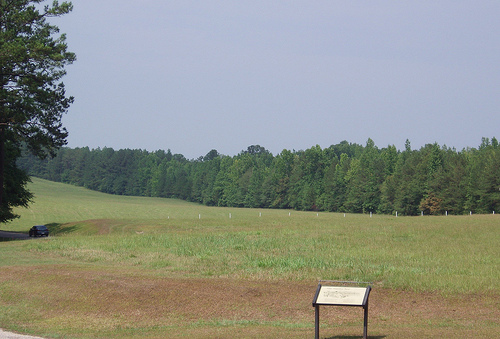

Location: Alexander City, Alabama Map
Area: 2,040 acres (8.26 km2)
Horseshoe Bend National Military Park is the site of a fierce
battle of the same name. It is located in east central Alabama
(United States) and is administered by the National Park Service.
The park was established on July 25, 1956 and occupies 825.56
hectares.
On March 27, 1814, some 3,300 men of General Andrew
Jackson's army attacked the nearly 1,000 "Red Sticks" warriors led
by Creek Nation chief Menawa. His forces were fortified in a
horseshoe bend. in English) of the Tallapoosa River from which the
battle took its name. This was the last battle of the creek war. The
decisive victory at Horseshoe Bend ended the power of the Creek
Nation. More than 800 members of the Upper Creek Nation died
defending their homeland. This was the largest loss of American
Indian life in a single battle in the history of the United States.
On August 9, 1814, the Creek Nation signed the Treaty of Fort
Jackson. This act ceded 93,000 square kilometers of land located in
Alabama and Georgia to the United States government.
The Battle of Horseshoe Bend, fought on March 27, 1814, was the
decisive battle of the Creek War of 1813-1814. The site where the battle
was fought is today protected as Horseshoe Bend National Military Park.
Warring parties
On one side were about 1,000 soldiers from the
Red Sticks, the traditionalist faction of the Creek Indians, who had
camped near a bend in the Tallapoosa River.
On the other side
were American troops from the Tennessee National Guard and an infantry
regiment from the United States Army under Andrew Jackson, together
2,000 infantry, 700 cavalry and artillery, as well as about 600 allied
Cherokees and Choctaws and White Sticks Creek from the lower
pro-American towns.
The battle
Jackson sent the cavalry and
Native American allies south across the river to surround the Red
Sticks, while he himself remained with the infantry north of their camp.
On the morning of March 27, Jackson's artillery opened fire, which was
maintained for two hours, but the firing resulted in no visible damage
to Red Stick's field works. The cavalry and Indians crossed the river
and attacked the Red Sticks in the rear. The infantry then stormed the
parapets and opened fire on the Red Sticks inside. The battle lasted for
five hours. About 550 Red Sticks were killed inside the camp, while many
others were killed trying to escape across the river. Only about 200 Red
Sticks soldiers managed to escape and fled to Florida, where they joined
the Seminoles.
The climate is humid and subtropical. The average temperature is 16 °C. The warmest month is July, at 24 °C, and the coldest is January, at 4 °C. The average rainfall is 1,523 millimeters per year. The wettest month is February, with 227 millimeters of rain, and the driest is October, with 46 millimeters.